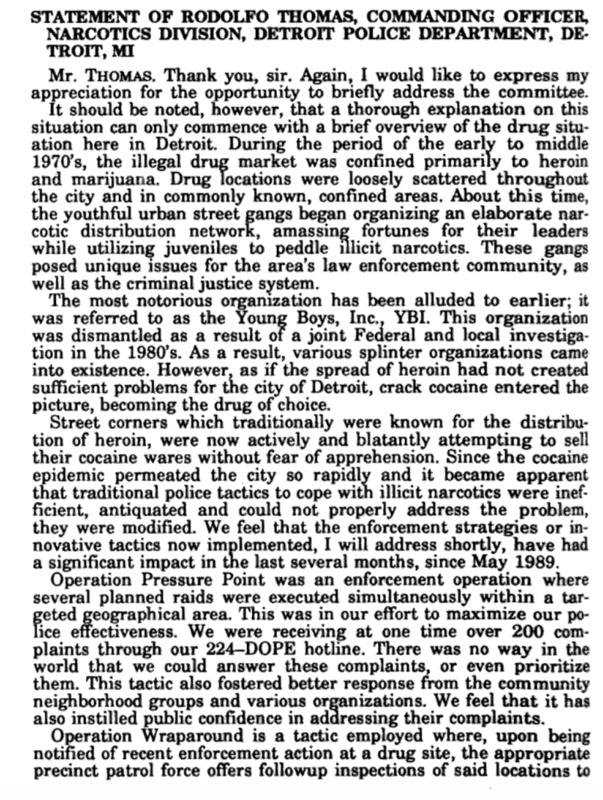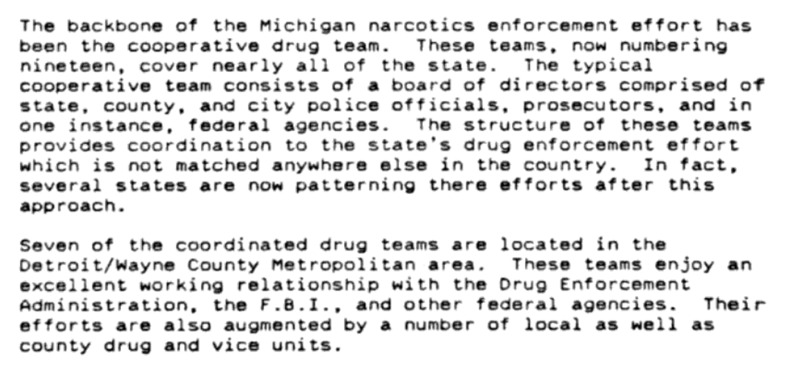Operation Crack Crime
As the national and state-level war on drugs and crime heightened, Detroit officials proceeded in their own escalation. In this period of time between 1986-1989, Operation Crack Crime, a program carried out by the Detroit Police Department, was the most aggressive and targeted attack on drugs. This operation, put in place to theoretically gain control over crack, afforded officers the right to raid, stop, and frisk nearly anyone without the fear of repercussions. The daily operations of Operation Crack Crime were kept in a log, with detailed reports of the effect they were having on crime reduction.
Crack, the focal drug of concern, was primarily associated with poorer, black communities, and therefore these are the areas in which the operation was most executed. Officers utilized multiple avenues of reconnaisance to scope out "potential" crack houses, each of which afforded them the ability to bypass a search warrant and instead raid the house on the basis of probable cause. As the scourge of crack houses and drug-related violence spread through the city, public support for drug raids skyrocketed, as did interaction between gang/raid units and federal DEA agents. Operation Crack Crime was one of many DPD initiatives to reflect the shift from street policing to a forced invasion of homes and spaces, along with an increase in military tactics.
The raids that came as a result of Operation Crack Crime indeed also reflect the value placed on the seizure of drug dealers' assets by the DPD. Raids, as discussed throughout this exhibit, became a vital source not only for profit for the DPD, but a scare tactic used to bolster the DPD's reputation as a "tough-on-crime" city in the national context of the War on Crack.
The lenience afforded by Operation Crack Crime allowed for the misuse of power by Detroit Police officers. Raids were, to an extent, a free-for-all in the capabilities of officers. In the example below, the actions of eight officers during a raid are outlined. Although this instance was documented and reported, many incidents were not. Beyond mere violence, the forfeiture of assets also posed an opening for misconduct by police under the operation. In this example, money and guns were stolen from the property, a frequent occurance during Crack Crime raids. Often times, as detailed below, the asset seizures occurred weeks after any raid may have happened; with the restructuring of policing during this time through the implementation of Operation Crack Crime, it is evident that as the War on Crack progressed, the Detroit Police Department allowed themselves special "war-time" leniency with regard to privacy rights and home searches.
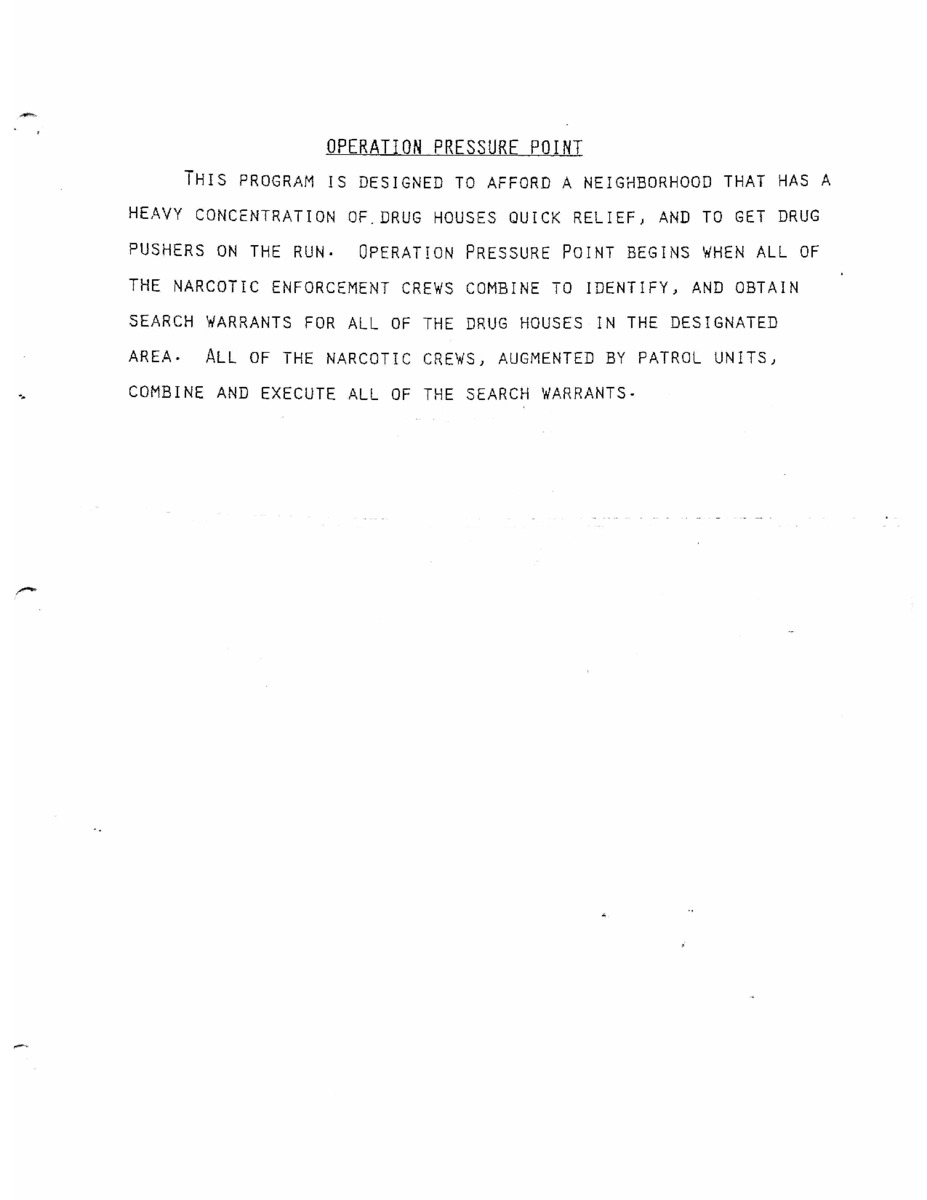
Operation Pressure Point
This document details an operation by the Detroit Police Department (taking place in 1989) as a part of Operation Crack Crime.
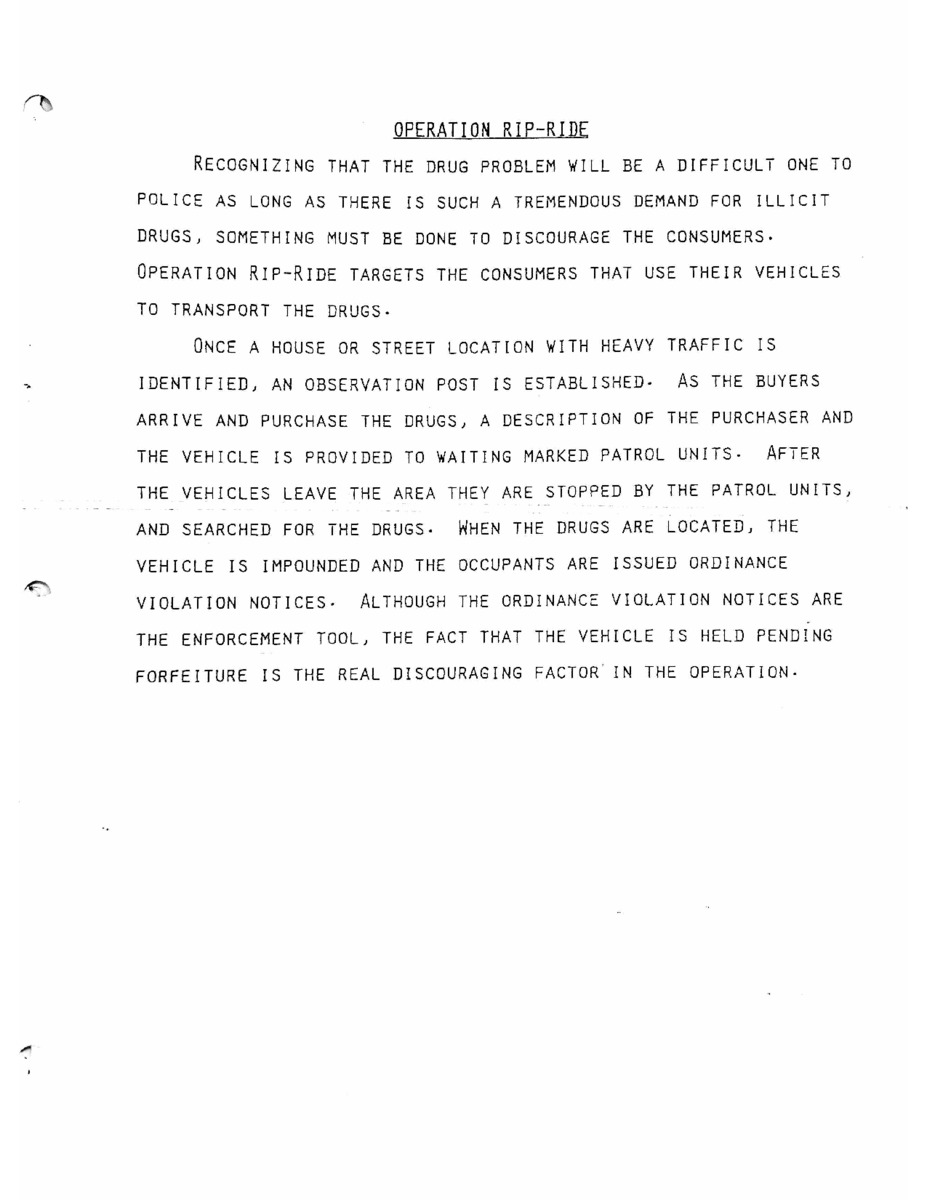
Operation Rip-Ride
This document details an operation by the Detroit Police Department (taking place in 1989) as a part of Operation Crack Crime.
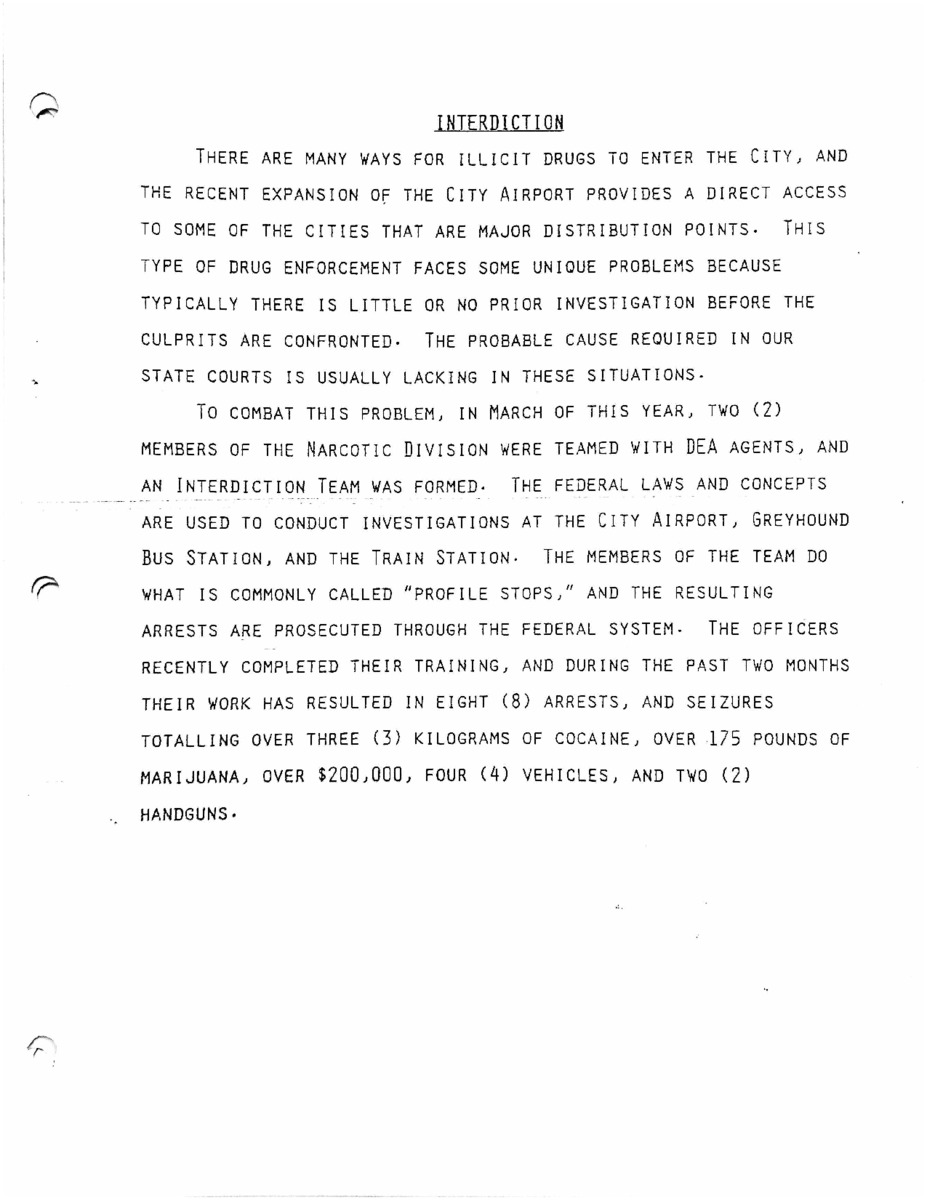
Interdiction
This document details actions by the Detroit Police Department (taking place in 1989) as a part of Operation Crack Crime.
Operation Crack Crime in Context: Police Drug Operations in the War on Crack
Operation Crack Crime was one of many initiatives supported by the Detroit branch of the DEA, in conjunction with the DPD, in order to heighten raid profits and centralize government funding on DPD SWAT projects. Crack Crime was the umbrella term for multiple individual operations conducted by subgroups of the DPD and oftentimes partially subsidized by the DEA. Various members of the Detroit Police offered testimony at national hearings on drug policy and enforcement, presenting Detroit as a model example of drug policing and intervention. The interplay between federal, state, and city-based initiatives often came in the form of various drug "Operations" which allocated funding for SWAT-like raids and armed confrontation between DPD officers and supposed drug dealers across Detroit. Members of law enforcement and federal officials alike discussed net profits of asset forfeiture, illegal entry into homes only suspected of drug use, and the fiscal yield of "successful" projects like Operation Crack Crime. Detroit became the site of unprecedented federal, state, and city-wide law enforcement experimentation and exploitation because of its national reputation as a "drug-ridden" city.
One notable source in deconstructing and decoding the place of operations like Operation Crack Crime in a larger, federal context during the mid-to-late 1980s is testimony by agent William Coonce. Coonce was a special agent of the Drug Enforcement Administration in Detroit during this time, and he testified in a joint hearing before the Legislative and National Security Subcommittee of Congress on December 14th, 1989. Coonce discusses strategies used by the DPD for raiding houses owned by alleged drug dealers, seizing various assets. One notable aspect of Michigan's drug enforcement policy is the acquisition of "drug teams" set up across multiple counties across the state, each comprised of law enforcement officials, prosecutors, and sometimes indpendent third party federal agencies -- all of which decided the strategies of enforcement and investigation for drug crimes in their respective areas. Operation Crack Crime was created and implemented under a policing framework approved by the Detroit/Wayne county "drug team." It is a prime example, as is Coonce's testimony in this hearing itself, of the desire by Detroit law enforcement officials to secure federal funding for violent and invasive police procedure.
Rodolfo Thomas, the Commanding Officer of the Narcotics Division of the DPD, also gave testimony at this hearing. He detailed various operations and raid-based projects which the DPD had started within the two years prior. The sheer number of projects and subsequent raids conducted by the DPD in the mid-to-late 1980s indicates the intense and suffocating focus placed on drug seizures and home entries as more and more funding was allocated for militarized SWAT units.
The Operations listed in Thomas's testimony are as follows:
- Operation Pressure Point
- Operation Crackdown
- Operation Rip Ride
- Operation Crack Crime
- Operation Wraparound
Operation Wraparound:
Operation Wraparound is a particularly intriguing example of the DPD's initiatives under Operation Crack Crime. This operation largely functioned after raids had been conducted on a suspected drug den: it dictated that patrol officers conduct followup investigations on houses which had recently been raided. This operation was primarily a DPD project and required little intervention by the federal government or the DEA aside from not disproving the operation over legal grounds.
What is so fascinating about Wraparound as an example of the heightened militarization of the DPD that came with Operation Crack Crime is that it required very little by way of probable cause or warrants for officers to conduct these random "inspections." In fact, the basis for raiding the houses was in fact retroactive: to see if there was any continued drug dealing or misconduct occurring in the wake of a drug seizure. This is a nearly blatant disregard for the doctrine of privacy and the right against illegal search and seizure, and was not only instituted across low-income areas of Detroit's east and west sides, but lauded in a federal hearing as a "pro-active" move by the DPD.
Furthermore, should any implementations of Operation Wraparound fail, the DPD adopted contingency measures that assured some profit and asset seizure. While testimony did not explicitly reveal what "dail" meantinthis context, it can be reasonably assumed that it refers to an inability to enter or secure drug assets from a house during one of the random Wraparound "inspections," or possibly that one raid did not completely cease all drug trafficking occurring in that given residence. This contingency plan was referred to as "padlock policy," in which if a home is raided three times (or three raid attempts are made, success level unspecified), the entire house can be seized by the DPD under the "Nuisance Abatement Act," and the property given to the investigative agency itself. This became a feature of the DPD's "deterrent" tactics against recidivism in drug usage and sale throughout the late 1980s.



